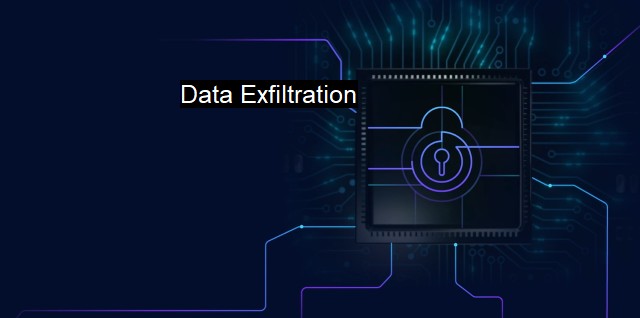What is Data Exfiltration?
The Dangers of Data Exfiltration: Understanding the Tactics, Techniques, and Terminology of Cyber Attacks
Data exfiltration refers to unauthorized transfer of data from a computer or server. This action is typically conducted by cybercriminals who have successfully breached the security protocols of a system, and its occurrence often signifies a high-risk security threat. It's this notion - the illicit conveyor-like flow of confidential information from an internal network to an external location- that makes data exfiltration particularly damaging to individuals, businesses, organizations, and governments.Data exfiltration is a multi-stage process. First, an attacker infiltrates a network security, most often through malware injection or phishing. Once the network’s defense is breached, cybercriminals navigate through the system, identify, and then collect the targeted data. After collection follows data exfiltration itself - the movement of the data out of the victim's network into a controlled environment. The specific conveyor methods may vary according to the sophistication level of cybercriminals and the degree of network security. Cybercriminals may employ commonly used protocol and methods such as FTP, HTTP or DNS tunneling to avoid suspicion.
The targeted data significantly varies in nature, from personally identifiable information (PII) and protected health information (PHI), to sensitive corporate information and intellectual properties. This category does also extend to restricted information relating to national security. In each scenario, the possible consequences of data exfiltration are severe, ranging from identity theft and financial loss, to serious disruptions in corporate operations, not to mention the psychological damage of a security breach.
Surprising as it may sound, data exfiltration is not always conducted externally. Insiders - discontented employees or curious individuals can turn into silent attackers and may pose a significant threat to an organization's cybersecurity. This is what makes data exfiltration more complex compared to hacking and other forms of cyber-attacks. It is neither entirely external nor internal but can interchange depending on the varying dynamics.
What makes it extremely challenging to deal with data exfiltration is its subtle and quiet nature. Cybercriminals can exfiltrate data slowly over time, making it hard for traditional identification tools like firewalls and intrusion detection systems to notice the breach. attackers often use encryption to move stolen data, which adds another layer of concealment.
Traditional methods such as encryption, firewalls, and network monitoring have been employed to prevent data exfiltration, assisting in data surveillance, understanding activity trends, and recognizing possible security threats. Recent advancement in technology has also seen the rise of Antivirus software with capabilities designed to minimize instances of data exfiltration by detecting malicious traffic.
Perhaps most promising is the development and integration of machine learning and artificial intelligence in cybersecurity measures. Machine learning algorithms are now utilized to provide predictive modelling of possible threats, behavior analytics of users, and network events. These serve to identify unusual patterns within the network, and thus, flag potential data exfiltration activities.
Meanwhile, organizations themselves are implored to cultivate a cybersecurity-based culture where continuous education regarding cyber threats and reinforcement of security protocol measures are highlighted. Employee training against social engineering tactics, for instance, can substantially decrease the success risk of phishing, malware intrusion, and data exfiltration.
Data exfiltration presents a serious threat to privacy, security and integrity of data for both individuals and organizations. It requires deep understanding and strategic responses involving technical reinforcements and behavioral changes. While it poses a significant challenge, the evolving landscape of cybersecurity also presents several promising weapons and tactics to ensure that everyone's digital frontiers remain secure and confidential.

Data Exfiltration FAQs
What is data exfiltration in the context of cybersecurity?
Data exfiltration refers to the unauthorized transfer of sensitive data from a computer or network to an external location controlled by an attacker. It is a major security concern for organizations as it can result in data breaches and significant financial damage.How can data exfiltration be prevented in a network?
Data exfiltration prevention can be achieved by implementing security measures like firewalls, intrusion detection systems, and data loss prevention software. Additionally, organizations can use encryption to secure their data, limit employee access to sensitive information, and conduct regular security audits to detect any vulnerabilities.What are some common methods used for data exfiltration?
Some common data exfiltration methods include using email attachments, cloud storage services, and instant messaging platforms. Other methods include disguising data within non-sensitive files, using steganography to hide data within images or videos, and using remote access tools to gain access to organizational networks.How can antivirus software help protect against data exfiltration?
Antivirus software can help protect against data exfiltration by detecting and blocking malware that could be used to steal data. Modern antivirus software also includes features like firewalls, intrusion prevention, and behavior analysis to help detect and prevent data exfiltration attempts by hackers. Regular updates to antivirus software are also essential to stay ahead of new and emerging threats.| | A | | | B | | | C | | | D | | | E | | | F | | | G | | | H | | | I | | | J | | | K | | | L | | | M | |
| | N | | | O | | | P | | | Q | | | R | | | S | | | T | | | U | | | V | | | W | | | X | | | Y | | | Z | |
| | 1 | | | 2 | | | 3 | | | 4 | | | 7 | | | 8 | | |||||||